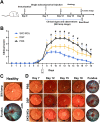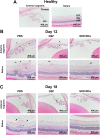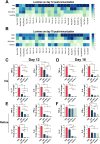Long-acting acid-sensitive ketal-linked dexamethasone microcrystals for treating experimental autoimmune uveitis
- PMID: 36313265
- PMCID: PMC9612960
- DOI: 10.1063/5.0118311
Long-acting acid-sensitive ketal-linked dexamethasone microcrystals for treating experimental autoimmune uveitis
Abstract
Corticosteroids have for some time been used as first-line drugs for the topical treatment of noninfectious uveitis, but poor ocular bioavailability and the rapid clearance of eye drops necessitate frequent dosing, reducing patient compliance. In this study, we used an acid-sensitive stearoxyl-ketal-dexamethasone pro-drug microcrystals (SKD MCs), which is consistently safe and effective in the control of uveitis inflammation in rats. We used a rat model of experimental autoimmune uveitis (EAU) to evaluate the effects of SKD MCs in terms of clinical manifestations, molecular biology, pathological histology, and visual electrophysiology compared to dexamethasone sodium phosphate injection or phosphate-buffered saline. SKD MCs significantly reduced inflammation in EAU, improved the ability to suppress inflammatory cytokines and to protect retinal function, and significantly reduced retinal microglia activation, with no increase in intraocular pressure throughout the treatment. Our results indicate that the SKD MCs formulation holds promise as a new strategy for the treatment of noninfectious uveitis and potentially other ocular inflammatory diseases.
© 2022 Author(s).
Figures






Similar articles
-
Subconjunctival injection of microcrystalline prodrug of dexamethasone for long-acting anti-inflammation after phacoemulsification surgery.J Control Release. 2025 Jan 10;377:399-412. doi: 10.1016/j.jconrel.2024.11.046. Epub 2024 Nov 27. J Control Release. 2025. PMID: 39571655
-
Controlled release of corticosteroid with biodegradable nanoparticles for treating experimental autoimmune uveitis.J Control Release. 2019 Feb 28;296:68-80. doi: 10.1016/j.jconrel.2019.01.018. Epub 2019 Jan 17. J Control Release. 2019. PMID: 30660629 Free PMC article.
-
Intra-Articular injection of acid-sensitive stearoxyl-ketal-dexamethasone microcrystals for long-acting arthritis therapy.Asian J Pharm Sci. 2021 Mar;16(2):213-221. doi: 10.1016/j.ajps.2020.07.002. Epub 2020 Jul 30. Asian J Pharm Sci. 2021. PMID: 33995615 Free PMC article.
-
[Intraocular inflammation and homeostasis of the eye].Nippon Ganka Gakkai Zasshi. 2009 Mar;113(3):344-77; discussion 378. Nippon Ganka Gakkai Zasshi. 2009. PMID: 19348183 Review. Japanese.
-
Development of a dexamethasone intravitreal implant for the treatment of noninfectious posterior segment uveitis.Ann N Y Acad Sci. 2015 Nov;1358:1-12. doi: 10.1111/nyas.12824. Epub 2015 Jul 22. Ann N Y Acad Sci. 2015. PMID: 26200808 Review.
Cited by
-
Long-Acting Ocular Injectables: Are We Looking In The Right Direction?Adv Sci (Weinh). 2024 Feb;11(8):e2306463. doi: 10.1002/advs.202306463. Epub 2023 Nov 28. Adv Sci (Weinh). 2024. PMID: 38018313 Free PMC article. Review.
-
Drug/gene delivery and theranostics.APL Bioeng. 2023 Oct 9;7(4):040401. doi: 10.1063/5.0165227. eCollection 2023 Dec. APL Bioeng. 2023. PMID: 37822770 Free PMC article. No abstract available.
-
Non-histone lactylation: unveiling its functional significance.Front Cell Dev Biol. 2025 Jan 24;13:1535611. doi: 10.3389/fcell.2025.1535611. eCollection 2025. Front Cell Dev Biol. 2025. PMID: 39925738 Free PMC article. Review.
-
Combined Therapy of Experimental Autoimmune Uveitis by a Dual-Drug Nanocomposite Formulation with Berberine and Dexamethasone.Int J Nanomedicine. 2023 Jul 31;18:4347-4363. doi: 10.2147/IJN.S417750. eCollection 2023. Int J Nanomedicine. 2023. PMID: 37545873 Free PMC article.
References
LinkOut - more resources
Full Text Sources

